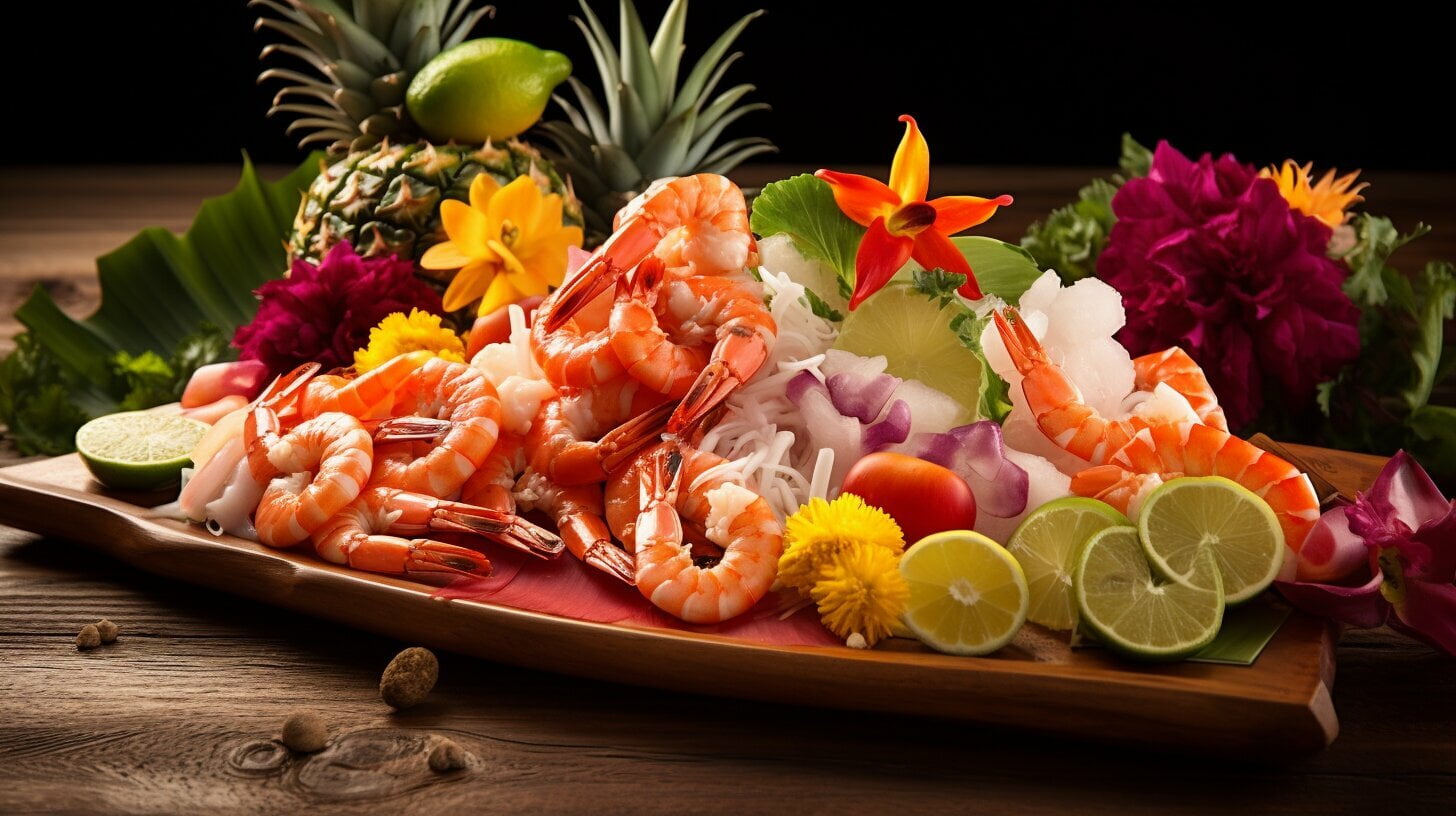🌺 Experience the Rich Flavors of Authentic Hawaiian Cuisine 🍍
Hawaiian cuisine is a delightful blend of flavors, influenced by the diverse cultures and rich food traditions of the Pacific Polynesian islands, resulting in an array of mouthwatering dishes that showcase the true essence of Hawaii. From traditional Hawaiian favorites to modern fusion creations, the culinary traditions of Hawaii offer a unique and satisfying dining experience.
Key Takeaways:
- Hawaiian cuisine is a fusion of flavors from the Pacific Polynesian islands and various cultures.
- Traditional Hawaiian dishes like poi, laulau, and kalua pig are beloved by locals and highlight the staple ingredients of the region.
- Poke and other Hawaiian seafood dishes showcase the freshness and variety of seafood available in Hawaii.
- The culinary traditions of Hawaii are a journey through history, showcasing the diverse cultural influences that have shaped the cuisine of the islands.
Many traditional Hawaiian foods have their roots in the Pacific Polynesian islands, and they continue to be cherished as the true tastes of Hawaii. From staple dishes to beloved favorites, Hawaiian cuisine offers a unique and delicious culinary experience. Let’s explore some of the traditional Hawaiian food and staple dishes that have stood the test of time.
Traditional Hawaiian Food and Staple Dishes
Traditional Hawaiian food showcases the flavors and ingredients native to the islands. These dishes have been passed down through generations and are still enjoyed by locals and visitors alike. Let’s dive into some of the staple dishes that define traditional Hawaiian cuisine.
Poi – Traditional Hawaiian Staple Dish
One of the most iconic dishes in Hawaiian cuisine is poi. Made from taro root, poi is a thick paste that can have a sticky pudding-like consistency. The preparation process involves steaming or baking the taro root and then pounding it with water to achieve the desired texture. Poi has a unique flavor that is starchy and slightly sour due to the light fermentation. It may take some getting used to, but it is an essential part of experiencing authentic Hawaiian cuisine. For the best taste, fresh poi is recommended over powdered poi.
Laulau
Another traditional Hawaiian favorite is laulau. This dish is made by wrapping pork in layers of taro leaves and cooking it in an underground hot rock oven for hours. The result is tender and juicy meat with smoky flavors, while the taro leaves become spinach-like in consistency. Although pork is the traditional choice, variations with fish, chicken, or other meats can also be found in Hawaii.
Kalua Pig
Kalua pig is a famous dish in Hawaiian cuisine that is cooked using an imu, an underground oven. The pork is slow-roasted in the imu, which gives it a tender texture and a remarkable smoky flavor. Kalua pig is similar to southern American pulled pork, but it has its unique Hawaiian twist with a hint of wood smoke. It pairs wonderfully with a serving of rice and is a must-try dish for any visitor to Hawaii.
Poke
Poke is the Hawaiian version of Japanese sashimi, and it has gained popularity worldwide. Instead of thinly slicing the fish, Hawaiian poke is served in bite-sized hearty cubes. The most common fish used is ahi (tuna), but other saltwater fish varieties are also popular. There are endless varieties of poke in Hawaii, with different marinades and combinations of flavors. From traditional shoyu poke seasoned with soy sauce and Hawaiian sea salt to spicy mayo poke, there is a poke for every palate. The rise of poke bowls, which feature a bed of rice topped with poke, has further enhanced the popularity of this Hawaiian delight.
Lomi Salmon
Lomi salmon, also known as lomi-lomi salmon, is a traditional Hawaiian salmon salad. It consists of diced raw salmon cured with salt, mixed with tomatoes, onions, and sometimes chili peppers. The combination of flavors creates a refreshing and tangy taste that perfectly complements other Hawaiian dishes. Lomi salmon is often enjoyed as a side dish or garnish alongside poi or other traditional Hawaiian feasts.
These are just a few examples of the traditional Hawaiian food and staple dishes that showcase the unique flavors of the islands. From the starchy goodness of poi to the smoky deliciousness of kalua pig, Hawaiian cuisine is a culinary journey worth exploring. So, when you visit Hawaii, don’t miss the opportunity to indulge in the authentic tastes and traditions of Hawaiian cuisine.
| Dish | Description |
|---|---|
| Poi | A traditional Hawaiian staple made from taro root, pounded to a sticky pudding-like consistency. It has a unique starchy and slightly sour flavor. |
| Laulau | Pork wrapped in layers of taro leaves and cooked in an underground hot rock oven. The result is tender meat with smoky flavors. |
| Kalua Pig | Pork slow-roasted in an underground oven, known as an imu, resulting in tender meat with a distinctive smoky flavor. |
| Poke | Hawaiian version of Japanese sashimi, featuring bite-sized cubes of raw fish with various marinades and flavors. |
| Lomi Salmon | A salmon salad made with diced raw salmon, tomatoes, onions, and sometimes chili peppers. It has a tangy and refreshing flavor. |
“The unique flavors of traditional Hawaiian cuisine truly reflect the rich culinary traditions and vibrant food culture of Hawaii.” – Chef Kimo, Hawaii Culinary Institute
The Unique Flavors of Poi
The staple and traditional filler starch dish in Hawaiian cuisine is the famous poi, a thick paste made from taro root that is cooked, pounded, and mixed with water to create a sticky, pudding-like consistency. Poi has a unique flavor that is starchy and slightly sour, resulting from the light fermentation in the preparation process.
This traditional Hawaiian dish holds great cultural significance and is a beloved part of Hawaiian food culture. Poi is commonly served as a side dish or accompaniment to other Hawaiian delicacies, enhancing the overall dining experience.
Preparation and Cultural Significance
Poi is prepared by cooking taro root until it becomes tender, then pounding it into a smooth paste with added water. The consistency can vary from liquid to firm, depending on personal preference and the occasion. Fresh poi has a subtle sweetness, while fermented poi has a slightly tangy and sour taste.
The preparation process of poi holds deep cultural significance in Hawaiian traditions. It is considered a communal activity, where multiple people gather to pound the taro root, creating a sense of togetherness and shared connection to the land.
Unique Flavor Profile
Poi’s flavor is distinct and unlike any other dish. The starchy texture and slight tanginess give it a taste that is both comforting and intriguing. Its flavor can be enhanced by adding complementary ingredients, such as lomi-lomi salmon, which adds a savory element to the dish.
Enjoying Poi in Hawaiian Cuisine
Poi can be enjoyed in various ways. Many locals eat it on its own, savoring the simplicity of its flavors. Others use it as a dip or topping for meat dishes, adding a unique twist to traditional Hawaiian meals. The versatility of poi allows for creative pairings and combinations, making it a versatile ingredient in Hawaiian cuisine.
| Poi Fact | Details |
|---|---|
| Traditional Hawaiian Dish | Poi has been a staple in Hawaiian cuisine for centuries, deeply rooted in Hawaiian cultural traditions. |
| Taro Root | Poi is made from taro root, a starchy vegetable with a unique flavor that is central to Hawaiian cooking. |
| Sticky Pudding Consistency | After being cooked, pounded, and mixed with water, taro root transforms into a thick paste with a sticky pudding-like consistency. |
Poi is not just a dish, but a representation of the rich culinary traditions and vibrant food culture of Hawaii. Exploring the unique flavors of poi allows visitors and locals alike to embark on a sensory journey through the traditions and flavors of authentic Hawaiian cuisine.
Savor the Deliciousness of Laulau
One of the most beloved traditional Hawaiian dishes is laulau, where tender pork is wrapped in taro leaves and slow-cooked to create a smoky and succulent delight. This dish has been a part of Hawaiian food culture for generations and continues to be a favorite among locals and visitors alike.
The Preparation Process
The process of making laulau involves carefully wrapping seasoned pork in layers of taro leaves. The pork is typically marinated with a combination of Hawaiian sea salt, garlic, and sometimes other spices to enhance the flavor. The wrapped bundles are then placed in an underground hot rock oven called an imu, where they are cooked for several hours. The slow cooking method allows the pork to become tender and juicy while the taro leaves infuse the dish with a smoky flavor.
“Laulau is made from the leaves of the taro plant, a well-respected plant in Hawaii and throughout the Pacific islands. The combination of pork and taro leaves wrapped together and cooked in an imu creates a unique flavor and texture that is truly delicious.”
A Spinach-Like Consistency
As the pork cooks inside the taro leaves, the leaves themselves undergo a transformation. They turn soft and tender, resembling the texture of cooked spinach. This combination of flavors and textures creates a harmonious and satisfying eating experience.
Variations of Laulau
While traditional laulau is made with pork, there are also variations of this dish that feature fish or chicken as the main protein. Each variation offers its own unique flavor profile and can be enjoyed as part of a traditional Hawaiian feast.
Serving Suggestions
Laulau is often served as part of a plate lunch, accompanied by steamed rice and macaroni salad. The combination of the savory pork, smoky taro leaves, and comforting sides creates a well-rounded meal that is both satisfying and delicious.
A Favorite at Luaus
Luaus, traditional Hawaiian feasts, are incomplete without the presence of laulau. This dish is a centerpiece of the festivities and is enjoyed by both locals and tourists alike. Its rich flavors and cultural significance make it a must-try when experiencing Hawaiian cuisine.
| Ingredient | Description |
|---|---|
| Pork | Tender cuts of pork, typically marinated with Hawaiian sea salt, garlic, and other spices. |
| Taro Leaves | Large leaves from the taro plant, used to wrap the pork before cooking. |
| Hawaiian Sea Salt | Locally sourced sea salt, used to season the pork and enhance its flavor. |
| Garlic | Aromatic ingredient that adds depth of flavor to the dish. |
Experience the flavors of laulau, a traditional Hawaiian dish that showcases the unique combination of pork and taro leaves. The slow cooking process and smoky flavor make laulau a true delight for the taste buds. Whether enjoyed at a luau or as part of a plate lunch, laulau is a must-try for anyone seeking an authentic taste of Hawaiian cuisine.
No exploration of Hawaiian cuisine is complete without savoring the mouthwatering flavors of kalua pig.
Kalua pig is a traditional Hawaiian dish that has been enjoyed for centuries. It is a succulent pork dish cooked in an underground oven called an imu. The imu is a pit in the ground filled with volcanic rocks that are heated by fire. Once the rocks are hot, the pork, along with any accompanying vegetables, is wrapped in leaves, such as banana leaves, and placed in the imu. The food is then covered with wet leaves and earth, and left to steam and roast for many hours.
The unique cooking method of the imu imparts a remarkable smoky flavor to the kalua pig. The slow roasting process also ensures that the pork becomes extremely tender and retains its natural juices, resulting in a truly mouthwatering taste.
“The pork slow roasts so it becomes extremely tender and retains a remarkable smoky flavor.” – Second Source
Kalua pig is often compared to southern American pulled pork, but it has its own distinct flavor. Instead of being coated in tangy barbecue sauce, kalua pig has a pungent wood smoke flavor that sets it apart. The combination of the smoky taste and the tender texture of the pork makes it a beloved dish among locals and visitors alike.
This traditional Hawaiian delicacy pairs perfectly with a nice big pile of rice, allowing you to savor the flavors even more. Whether enjoyed at a traditional Hawaiian feast or in a local restaurant, kalua pig is a must-try dish for anyone looking to experience the authentic flavors of Hawaiian cuisine.
Experience the Smoky Goodness of Kalua Pig
| Key Points | Details |
|---|---|
| Cooking Method | Slow-roasted in an underground oven called an imu |
| Flavor | Remarkable smoky taste |
| Texture | Extremely tender and juicy |
| Comparison | Similar to Southern American pulled pork, but with a pungent wood smoke flavor |
| Best Served With | Rice |
No trip to Hawaii is complete without indulging in the smoky goodness of kalua pig. Its unique cooking method and distinct flavor make it a standout dish in Hawaiian cuisine. So make sure to seek out this mouthwatering delicacy and satisfy your taste buds with the authentic flavors of Hawaii.
Immerse Yourself in the Vibrant Flavors of Hawaiian Seafood
Immerse yourself in the vibrant flavors of Hawaiian seafood, with the iconic poke leading the way as the Hawaiian version of Japanese sashimi. Unlike thinly sliced sashimi, Hawaiian poke is served in bite-sized hearty cubes, allowing you to savor the fullness of the fish. The most common type of fish used is ahi, or tuna, though other fresh saltwater fish are also commonly used.
There are numerous variations of poke that you can try in Hawaii, each offering a different marinade combination. From limu poke to shoyu poke to spicy mayo poke, the options are endless. Traditional shoyu poke features cubes of raw fish seasoned with a splash of good soy sauce, Hawaiian sea salt, sweet Maui onions, and perhaps some limu, a type of seaweed.
“Poke is the Hawaiian version of Japanese sashimi — it doesn’t get much better than poke — I’m in love and addicted. Every time I come back to Hawaii to visit family, poke is just about the first food I want to eat.” – Mark Wiens, Migrationology
Discover the Freshness of Lomi Salmon
Complementing the flavors of Hawaiian seafood is the traditional dish of lomi salmon. Although not originally native to Hawaii, it has become a staple in most traditional Hawaiian meals and makes a great addition to poi, a taro root dish.
Lomi salmon is a salad made with diced fresh tomato, raw salted salmon, and a mixture of Maui and green onions. The combination of the salty salmon, acidic tomatoes, and pungent onions creates a flavor profile that is truly cherished by Hawaiians.
“The salty flavor of the salmon paired with the acidic tomatoes and pungent onions is a flavor to cherish.” – Hawaiian Food Showcase
Indulge in an Abundance of Tropical Fruits
No Hawaiian feast is complete without the inclusion of an abundance of tropical fruits. The islands of Hawaii are renowned for their tropical fruits, with pineapples and passion fruit, known as liliko, being popular favorites.
Topping off a great Hawaiian meal, these freshly grown fruits bring a burst of sweetness and tanginess that perfectly complements the flavorful seafood and traditional dishes. As you indulge in the freshness of poke and lomi salmon, be sure to savor the tropical flavors of Hawaii’s bountiful fruits.
| Poke Varieties | Main Ingredients |
|---|---|
| Limu Poke | Raw fish seasoned with seaweed (limu), soy sauce, Hawaiian sea salt, sweet onions |
| Shoyu Poke | Raw fish seasoned with soy sauce, Hawaiian sea salt, sweet onions |
| Spicy Mayo Poke | Raw fish seasoned with spicy mayonnaise, soy sauce, sweet onions, chili peppers |
- Poke: The Hawaiian version of Japanese sashimi, served in bite-sized cubes.
- Lomi Salmon: A salad made with diced fresh tomato, raw salted salmon, and a mixture of Maui and green onions.
- Tropical Fruits: Indulge in the sweetness and tanginess of pineapples and passion fruits, known as liliko.
“Poke is the Hawaiian version of Japanese sashimi — it doesn’t get much better than poke — I’m in love and addicted. Every time I come back to Hawaii to visit family, poke is just about the first food I want to eat.” – Mark Wiens, Migrationology
Embracing the Culinary Journey of Hawaii’s Rich Food Traditions
Hawaii’s rich food traditions offer a delightful culinary journey, where the unique flavors of authentic Hawaiian cuisine can be savored and cherished, transporting you to the beautiful islands of the Pacific. With a vibrant food culture deeply rooted in its diverse culinary traditions, Hawaii’s cuisine showcases the influences of the native inhabitants, Polynesian cultures, and the waves of immigrants who have shaped the island’s food scene over the years.
Traditional Hawaiian food plays a significant role in the local cuisine, with staple dishes that have been enjoyed by generations. From the famous poi, a thick paste made from taro root with a unique starchy and slightly sour flavor, to laulau, a dish of pork wrapped in layers of taro leaves and cooked to perfection, these traditional favorites embody the essence of Hawaiian culinary heritage.
Diving further into the flavors of Hawaii, one cannot miss the smoky goodness of kalua pig. Cooked using the traditional imu cooking method in an underground oven, the pork becomes tender, retaining a remarkable smoky flavor that pairs perfectly with a serving of rice.
Seafood takes center stage in Hawaiian cuisine, with the popular dish of poke leading the way. Hawaiian poke, a mouthwatering mix of bite-sized cubes of raw fish, is served in various marinades and flavors, showcasing the freshness of Hawaiian seafood. Another seafood delight is lomi salmon, a salad made with diced fresh tomato and raw salted salmon, enhancing the flavors of traditional Hawaiian meals.
As the culinary journey continues, exploring the fusion of flavors is essential. Hawaiian regional cuisine, inspired by the island’s diverse influences, blends traditional Hawaiian ingredients and cooking techniques with global cuisines. This fusion creates exciting flavor combinations, like sushi rolls with a Hawaiian twist and kalua pork tacos with pineapple salsa.
Throughout the entire culinary adventure, it is evident that Hawaii’s rich food traditions are a celebration of local ingredients, fresh seafood, and the creativity of talented chefs. From traditional dishes to fusion cuisine, the flavors of Hawaii are a true reflection of its vibrant cultural tapestry.
So, come and indulge in the unique flavors of authentic Hawaiian cuisine, immerse yourself in the culinary journey of Hawaii’s rich food traditions, and experience the true essence of the beautiful island culture.
FAQ
Q: What are some traditional Hawaiian staple dishes?
A: Some traditional Hawaiian staple dishes include poi, laulau, and kalua pig.
Q: What is poi and what does it taste like?
A: Poi is a thick paste made from taro root with a starchy and slightly sour flavor due to the preparation process.
Q: What is laulau and how is it made?
A: Laulau is a dish made with pork wrapped in layers of taro leaves and cooked in an underground hot rock oven for hours until tender and smoky flavored.
Q: What is kalua pig and how is it cooked?
A: Kalua pig is famous Hawaiian pork dish cooked in an underground oven known as an imu, resulting in a tender and smoky flavor.
Q: What is poke and what are some popular variations?
A: Poke is a Hawaiian version of raw fish salad, commonly made with ahi (tuna) and various marinade combinations such as shoyu poke, limu poke, and spicy mayo poke.
Q: What is lomi salmon and what are its key ingredients?
A: Lomi salmon is a salad made with diced fresh tomato, raw salted salmon, Maui and green onions, and sometimes chili peppers.
Q: What is the significance of Hawaiian food culture and culinary traditions?
A: Hawaiian food culture and culinary traditions reflect the multicultural influences on the islands, incorporating flavors from Polynesian, European, Asian, and other ethnic cuisines.







